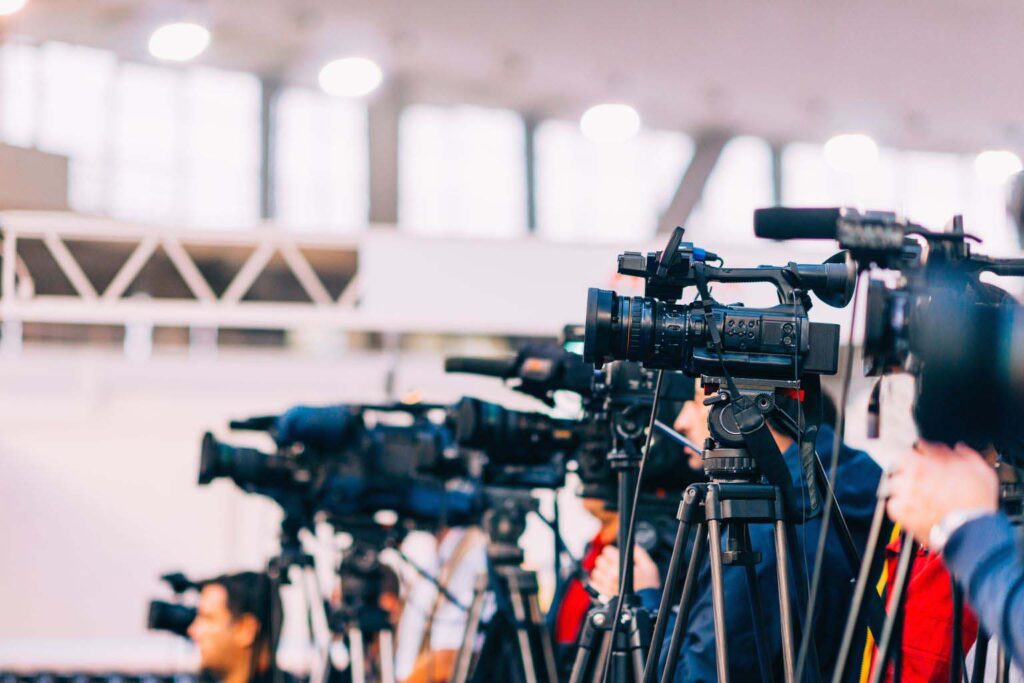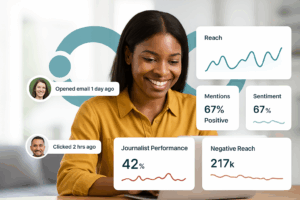Securing press coverage for an event takes more than just sending a press release.
Journalists receive hundreds of pitches every day, and only a fraction make it to print or online publication. To stand out, your story needs to be relevant, newsworthy, and presented in a way that makes a journalist’s job easier, not harder.
This guide will walk you through every step, from crafting a compelling story and building your media list to distributing your release, engaging journalists, and tracking results, so your next event gets the attention it deserves.
Why Press Coverage Still Matters in 2025
Even with the dominance of social media and paid campaigns, press coverage remains a crucial element of a successful event strategy.
It provides third-party validation that builds credibility and generates excitement that paid promotion alone cannot achieve.
The Role of Earned Media in Brand Credibility
Coverage in respected publications is considered earned media, which is content created and published by independent sources, rather than paid advertising.
It’s what gives your event legitimacy in the eyes of your audience. You can read more about how earned media supports credibility and long-term visibility on our dedicated page.
How Press Mentions Drive Event Awareness and Attendance
An event featured in relevant media outlets gains exposure to new audiences that organic posts may never reach.
Journalists amplify your reach by telling your story through their own trusted platforms, helping you drive sign-ups, ticket sales, and participation.
Examples of Successful Event Media Coverage
From local charity fundraisers featured in community newspapers to major product launches covered by trade press, media coverage builds trust and excitement.
Each mention validates your efforts, turning your event into a credible talking point long after it has ended.
Step 1: Define a Strong Event Story
Before you can earn coverage, you need a story journalists will want to tell.
Identify What Makes Your Event Newsworthy
Ask yourself: why should people care? Newsworthiness often comes from uniqueness, relevance, timing, or human impact.
Focus on what makes your event different, whether it’s tied to a significant milestone, responds to current trends, or features notable speakers or participants.
Craft a Compelling Media Angle
A good story goes beyond listing event details. Frame your event around a bigger idea that aligns with the publication’s audience.
For example, is it part of a wider industry movement? Does it reflect local innovation or community value?
Align Your Story with Trends or Seasonal Relevance
Timing strengthens your pitch. If your event coincides with an industry conference, awareness day, or holiday season, connect your story to that moment.
Journalists appreciate when stories fit naturally within broader cultural or business contexts.
Step 2: Prepare Your Press Materials
Strong, clear press materials make it easy for journalists to cover your event quickly and accurately.
The Anatomy of a Professional Press Release
A standard press release should include:
- A headline that summarises the story in one line
- A first paragraph that answers who, what, when, where, why, and how
- Quotes from key speakers or organisers
- Background information about your company or organisation
- Contact details for follow-up
Keep it concise and avoid jargon. Always write in third person, as journalists should be able to lift your text directly into their article if needed.
Visuals, Quotes, and Event Details Journalists Need
Journalists need more than text. Include high-resolution images, official logos, speaker headshots, and relevant statistics or research.
Compelling visuals and credible data increase your story’s chances of being picked up.
Building a Clear and Consistent Media Kit
Alongside your release, create a media kit that consolidates all relevant assets in one place, including images, videos, the event schedule, bios, and background information.
Step 3: Build and Segment Your Media List
Knowing who to contact is just as important as knowing what to say.
How to Identify Relevant Journalists and Outlets
Look for journalists who cover your industry, niche, or type of event. Research past articles to understand their tone and preferred topics.
Keep track of their contact details and publication guidelines.
The Difference Between Local, National, and Trade Media
- Local media value community impact. They’re perfect for events with regional relevance or social value.
- National outlets look for scale, major announcements, or big-name participants.
- Trade publications focus on specialist insight. They’re vital if your event targets professionals in a specific industry.
A balanced mix across these categories helps you maximise visibility.
How to Personalise Outreach for Better Response Rates
Don’t send mass emails. Personalise each message with a short, specific note that demonstrates your knowledge of the journalist’s work and how your event aligns with their beat. Reference a recent article or column where appropriate.
Step 4: Time Your Outreach Strategically
Timing can make or break your coverage.
When to Send Your Press Release
Send your release two to three weeks in advance of the event so journalists can plan their coverage accordingly. For larger campaigns or national publications, extend this to a month.
Avoid Fridays and late afternoons when inboxes are crowded or teams are signing off for the week.
How to Follow Up Without Spamming Journalists
Wait three to five days before sending a polite follow-up. Reiterate your story briefly, thank them for their time, and provide any new angles or updates as needed. If there’s no response after two attempts, move on.
Making Your Email Pitch Stand Out
Keep your email short and focused. Use a clear subject line such as “Local Innovation Forum: Interview Opportunities with Industry Leaders.” Include the most newsworthy detail first, then link to your newsroom or media kit for more context.
Step 5: Use the Right Press Distribution Platform
The platform you use to send your release affects how far and accurately your story travels.
Why Distribution Is Key to Event Visibility
Even the best release can fall flat if it doesn’t reach the right inboxes. Professional distribution ensures your content is delivered to verified media contacts and tracked for engagement.
How Newspress Connects Brands with Verified Journalists
Through advanced filtering, Newspress connects your story with active, relevant journalists across industries and regions. You can manage recipients, track open rates, and measure resulting coverage to see what resonates.
For event press coverage, this means your release reaches journalists most likely to cover your industry, location, or event type, whether it’s a corporate launch, charity fundraiser, or trade exhibition.
Newspress helps you build targeted outreach lists, share event details and visuals, and follow engagement in real time. By ensuring your story lands with the right reporters ahead of the event, you increase your chances of securing meaningful coverage that drives attendance, awareness, and post-event visibility.
Hosting Your Press Release, Images, and Assets in a Newsroom
Store everything in a digital newsroom like myNews, where journalists can access assets anytime. This central hub ensures your press materials stay organised and consistent across campaigns.
Maximise Your Reach With Press Release Distribution
Use professional press release distribution services to streamline how you share your event updates.
Distribution tools help you control your message, measure its impact, and ensure your release reaches the right audience.
A targeted distribution strategy ensures that your event announcement doesn’t just circulate, it lands with journalists who have a genuine interest in your story.
Beyond basic email lists, advanced distribution platforms like Newspress allow you to tailor outreach by region, publication type, or journalist specialisation. This precision makes it easier to reach the right mix of local, trade, and national media outlets that can amplify your event’s visibility.
Automated tracking and reporting features also help you see how your release performs in real time. You can monitor open rates, downloads, and engagement metrics to gauge which journalists are interacting with your content.
These insights make it possible to refine your outreach for future events, ensuring each campaign performs better than the last.
By combining targeted distribution with clear performance data, your team can maximise every release’s impact, turning one event update into lasting media coverage and brand recognition.
Step 6: Engage Journalists During the Event
Media engagement doesn’t stop once the event begins.
How to Manage Media Invitations and RSVPs
Send press invitations early and provide all logistical details, including venue, timing, registration process, and available interview opportunities. Use a tool like myEvents to manage your media guest list and RSVPs in one place.
For events, plan your outreach in stages. Start with a short save-the-date sent to key journalists and outlets, followed by formal invitations a few weeks later, typically two to three weeks for local or trade press and four to six weeks for national media or larger launches.
Offer pre-briefs or embargoed materials to selected journalists, and include a concise media note with speaker bios, access details, Wi-Fi, and interview opportunities.
With myEvents, you can segment invitations by region or publication type, track responses, send reminders, and generate digital press passes for smooth on-site check-in.
After the event, follow up promptly with a recap, approved quotes and images, and links to your newsroom to support post-event coverage.
Coordinating Journalist Attendance on the Day
Designate a media liaison to greet journalists, handle credentials, and answer questions. Ensure they have access to Wi-Fi, seating, and photography areas.
Providing On-Site Press Kits and Interview Access
Make it simple for journalists to cover the event live by providing printed press kits or QR codes linking to your online newsroom. Offer scheduled interview opportunities with key spokespeople.
Managing Your Media Guest List with myEvents
With myEvents, you can coordinate invitations, manage attendance, and ensure follow-up materials reach each journalist after the event. This keeps communication seamless and data centralised.
Step 7: Amplify Coverage After the Event
Your post-event strategy determines how long the buzz lasts.
Sending Follow-Up Releases and Highlight Reels
Share a short follow-up release summarising event outcomes, attendance numbers, and key quotes. Include high-quality photos and video highlights. A concise “thank you” message goes a long way in maintaining relationships.
Repurposing Media Coverage for Social and Web
Feature your best articles, interviews, and mentions on your website and across social channels. Repurpose coverage into blog posts, infographics, or short clips to extend visibility.
Building Long-Term Relationships with Journalists
Follow up individually with journalists who covered your event to thank them and share valuable insights or data.
Offer exclusives for future stories and maintain ongoing contact, not just when you need coverage.
Step 8: Measure and Improve
Tracking results helps you refine future event strategies and demonstrate ROI.
How to Track Earned Media Mentions
Use media monitoring tools to track mentions across news, blogs, and social media. Assess where coverage appeared, its tone, and audience reach.
Newspress provides real-time visibility into how your event is performing across multiple channels, from national headlines to niche trade outlets. You can see which journalists or publications are driving the most engagement, monitor sentiment around your story, and measure how far your coverage has spread.
These insights help your team understand what resonated most with audiences and where to focus future outreach.
By analysing reach, tone, and publication type, you can refine your event PR strategy and build stronger, long-term relationships with the journalists who consistently deliver high-value earned coverage.
Evaluating ROI and Coverage Quality
Go beyond quantity. Measure engagement quality – readership, backlinks, and sentiment. Positive coverage in high-authority outlets often outweighs multiple low-impact mentions.
Using Insights to Refine Future Event PR
Analyse which angles performed best, when engagement peaked, and what journalists responded to.
Use these insights to inform your next campaign and continuously strengthen your media relationships.
For deeper evaluation, learn more about PR measurement and understand how to quantify visibility and performance more accurately.
Common Mistakes to Avoid
Even experienced teams can make missteps when managing event publicity.
Sending Generic, Non-Targeted Press Releases
Mass mailing irrelevant contacts reduces credibility. Always segment your media list to ensure your message lands with journalists who cover your topic.
Overlooking Niche or Trade Media
Smaller trade outlets often deliver the most engaged audiences. Don’t underestimate their ability to influence key industry decision-makers.
Failing to Follow Up Post-Event
Once the event ends, many teams stop communicating. Following up with results, photos, or thank-you notes strengthens relationships and increases your chance of future coverage.
Learn More About Getting Press Coverage
Mastering how to get press coverage for an event takes planning, creativity, and consistency.
By defining a clear story, preparing strong materials, and using professional distribution tools, you can transform a one-day event into long-term media exposure.
To see how Newspress can simplify your process and connect you with verified journalists, book a demo today.
FAQ
How Early Should I Start Contacting Journalists?
Begin outreach at least three to four weeks before your event. This gives publications time to plan features or assign reporters.
What Makes a Press Release Stand Out?
A good release tells a story, not just details. Focus on clarity, relevance, and real-world impact. Include quotes, data, and a human element.
How Do I Attract Journalists to Attend My Event?
Offer genuine value, access to experts, compelling visuals, or unique stories that their audience will appreciate. Make attendance effortless with clear information and on-site support.
How Can Newspress Help Increase Event Visibility?
Newspress provides tools that streamline event PR from start to finish, including press release distribution, media monitoring, and myEvents for guest management, helping you maximise your event’s visibility and media reach.







